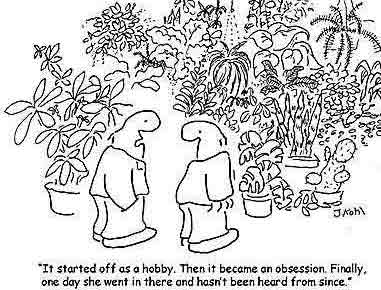
By Susie Hillman
∷史飞 选注
Plants pursue a never-ending quest for nourishment of the liquid and solar variety.[1] Clearly, the very essence of life. But what can our obsession with plants teach us about our own personal journeys?
My aunts, mom and grandma always talk about their plants when they get together. They trade cuttings, smuggling them over state lines to propagate at home.[2] They discuss their plants like children or pets. They share tips. Compare progress.
We turn plants into sentimental[3] objects as we do with books and art, but with plants it’s different because they’re alive. They grow and change. You see photographs of your former apartment, and there’s that peace lily, half its present size. It’s like looking at old family pictures: “Look how little you used to be!” Plants have a history and a life. That’s why they’re so hard to give up, even when you don’t love them anymore, even when you don’t have room for them. What are you supposed to do, just let them die? Impossible.
When I had to move everything out of my house recently, I realized there were more little plants than I was willing to find places for in my new cramped quarters.[4] I thought, it’s silly to be sentimental about these plants. I can replace them later if I want. Yet I just couldn’t give up the succulent[5] I kept alive during my first year of teaching.
It sat on top of a microwave, in a tiny, dark, cold office space that was really a storage closet with a window. During the times I thought I might lose my mind, I watched the plant’s health. It refused to wither. It stood hardy and strong, and occasionally sprung a tender new leaf. Sometimes I would forget to water it or take it home during vacations, but it withstood this neglect and stubbornly lived on. This buoyed[6] my spirit more than chocolate or pats on the back.
Our adopted foliage can serve as a sort of bellwether for our lives.[7] Most of us have gone through periods where we let the phone ring, the dishes pile up, and the houseplants shrivel.[8] Eventually, the pile of brittle leaves collecting beneath the ficus forces us to assess the state of our lives.[9]
Of course, because we have sentimentalized our plants, it’s tempting to read their lives for clues to our own. Once, when a relationship was dying, my African violet exploded with unseasonable purple flowers.[10] Maybe, I thought, there’s hope. There was—for the violet.
My stepmom visits a particular hemlock[11] in a park near her home every New Year’s Day. She walks circles around its trunk, one hand on the bark[12], releasing regrets from the old year and planning for the new one. Her own history and life is now intertwined with the hemlock’s, as year after year, the tree receives her hopes and ushers them forth with fresh oxygen.[13] “Here you go,” it says. “Here’s some more life.”
1. 植物总是孜孜不倦地汲取水分和阳光的种种滋养。
2. 她们跨越州界交换植物的插条,让它们在自己家里生根发芽。cutting: 插条,是从母株上截取的枝条,在适当条件下可培育出新的植株;smuggle: 偷运,走私;propagate: 繁衍。
3. sentimental: 寓有情感的,感情用事的,下文的sentimentalize指“为……而伤感”。
4. cramped: 狭小的;quarters:(常用作复数)住处。
5. succulent: 多肉植物。
6. buoy: 鼓励,振奋……的精神。
7. adopt: 收养;foliage: [总称] 叶,此处指观叶植物;bellwether: 楷模。
8. houseplant: 室内植物;shrivel: 枯萎。
9. brittle: 易碎的,此处指落叶干枯后易碎的状态;ficus: 热带榕属植物,其中某些种类为常见的室内植物。
10. African violet: 非洲堇;unseasonable: 不合季节的。
11. hemlock: 铁杉。
12. bark: 树皮。
13. intertwine: 交织;usher: 宣告;oxygen: 氧气。
(来源:英语学习杂志)